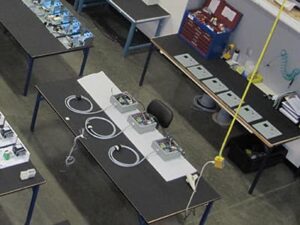In automated conveyor systems, control logic often depends on detecting where parts are, when a mechanism has reached its travel endpoint, or when to stop motion. Two common sensing technologies used for these tasks are limit switches and proximity switches (often simply called “proximity sensors”). Although people sometimes loosely say “limit or proximity control,” it’s more accurate to think of them as limit switches vs non-contact proximity sensors. Choosing between them properly is essential for reliability, safety, and performance.
What Is a Limit Switch?
A limit switch is a mechanical device that physically contacts a moving object or trigger to change state (open or close an electrical circuit). According to technical references, limit switches are triggered when motion or presence reaches a predefined boundary—hence the name.
How It Works
- A lever, roller, plunger, or actuator arm is placed in the path of a moving object.
- When the object hits that actuator, it mechanically moves the linkage inside the switch.
- That motion actuates contacts inside, changing their state (on → off, or off → on).
- These contacts are wired into control circuits (contactor, PLC input, etc.).
Advantages of Limit Switches
- Very definite mechanical feedback — you know the contact was physically made.
- Good for harsh environments (dust, dirt, vibration) where a sealed mechanical switch is simpler to maintain.
- Usually lower cost for simpler tasks.
Limitations & Wear
- Mechanical wear over time from repeated contact.
- Physical parts can misalign or degrade due to vibration or impact.
- Slower or less smooth for high-speed applications.
What Is a Proximity Switch (Sensor)?
A proximity switch (or proximity sensor) detects the presence or absence of an object without physical contact. Instead, it relies on electromagnetic fields, capacitance, or optical sensing approaches.
How It Works
- A sensing field (electromagnetic, capacitive, or optical) is generated from the sensor.
- When a target enters that field (or comes within its range), the sensor detects a change (disturbance, reflection, capacitance shift).
- That triggers its internal electronics and outputs a signal to the control system.
Advantages of Proximity Sensors
- No contact → minimal wear and very large lifecycle.
- High reliability in high-speed operations.
- Better for conditions where mechanical parts could fail (dust, debris, moisture) since no mechanical parts are in the path.
- Faster response times.
Challenges & Limitations
- More sensitive to environment (metal, temperature, electromagnetic interference).
- Need accurate tuning and alignment.
- Some sensors require shielding or tuning when detecting non-metallic materials.
Examples in Conveyor & Automation Systems
- End-of-travel detection: A conveyor carriage or shuttle reaches its endpoint. A limit switch is often used as a mechanical “hard stop.”
- Presence/position detection: A part arrives at a labeling station and needs to stop exactly. A proximity sensor can detect its presence without risk of impacting the part.
- Safety override: In a conveyor with potential overtravel, you might use a proximity sensor for control, plus a mechanical limit switch as backup in harsh or dangerous travel zones.
- Counting & indexing: For fast-moving lines, proximity sensors detect item passage reliably at speed without wear.
Which One Should You Choose?
Consider the Operating Conditions
If debris, impact, or harsh conditions are expected, a durable limit switch may be easier to maintain. For high-speed or high-cycle environments, a proximity sensor is often better given its non-contact nature.
Use Hybrid or Redundant Designs
Many systems combine both: use proximity sensors for most detection, and mechanical limit switches as safety backups. That way, if a proximity sensor fails, the limit switch acts as a last-resort stop.
Match to Control Logic
Your PLC, drives, or control panels built by Prairie Electric can support either sensor type. We’ll integrate whichever makes the most sense for your mechanical layout, speed, and reliability goals.
Limit vs proximity control often comes down to choosing a mechanical contact-based limit switch vs a solid-state, non-contact proximity sensor. Neither is universally better, but each has strengths and trade-offs. In conveyor automation, smart system design often uses both in complementary roles.
If you’re designing or retrofitting a conveyor or automated system and need help selecting, wiring, or programming limit or proximity switches, Prairie Electric can help. We design, build, and integrate control panels and sensor logic to keep your motors, actuators, and material flow in sync and safe.
Contact us to discuss your automation needs and let us help you build a system with the right sensors in the right places. We are local to Vancouver, WA but serve our industrial clients nationwide.
